
Dinagat Islands, officially the Province of Dinagat Islands, is an island province in the Caraga region of the Philippines, located on the south side of Leyte Gulf. The island of Leyte is to its west, across Surigao Strait, and Mindanao is to its south. Its main island, Dinagat, is about 60 kilometres (37 mi) from north to south.

Batomys is a genus of rodent endemic to the Philippines. It has six extant described species.

The golden spiny mouse gets its name from the reddish-orange spiny fur that covers its body from head to tail. This coarse, inflexible fur is thought to protect it from predation. Aside from the golden fur that covers its head and upper parts, its flanks are yellow and its underside is pale. It has gray legs with pale feet and black soles. It is also described as having a small, but distinct white spot under each eye. It is often found in the wild missing a part or all of its tail because it is able to shed this as a defense mechanism. However, it is not known how this is done, how often it can occur, or under what conditions. It lives an average of three years in the wild. It is omnivorous and feeds on seeds, desert plants, snails, and insects. Living in desert regions, it is a xeric animal that obtains water from the plants that it eats and produces very concentrated urine in order to conserve water. A. russatus is naturally nocturnal, but adapts to being diurnal when it shares a habitat with A. cahirinus.

Euryoryzomys emmonsae, also known as Emmons' rice rat or Emmons' oryzomys, is a rodent from the Amazon rainforest of Brazil in the genus Euryoryzomys of the family Cricetidae. Initially misidentified as E. macconnelli or E. nitidus, it was formally described in 1998. A rainforest species, it may be scansorial, climbing but also spending time on the ground. It lives only in a limited area south of the Amazon River in the state of Pará, a distribution that is apparently unique among the muroid rodents of the region.
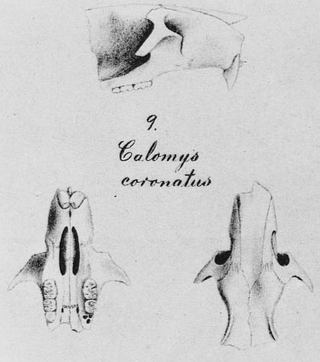
Euryoryzomys russatus, also known as the russet oryzomys, russet rice rat, or big-headed rice rat, is a species of rodent in the family Cricetidae. It is a member of the genus Euryoryzomys, which was split off from Oryzomys in 2006. It was first described by Johann Andreas Wagner in 1848. It is found in southern Brazil, eastern Paraguay and northeastern Argentina. It is considered a large species in its genus, with a reddish-brown coat, long tail length, and large skull. It is a terrestrial rodent, spending its time foraging for seeds, fruits, and insects. It is listed by the IUCN as least concern, although studies have shown it to be influenced by anthropogenic disturbances. Predators consist of small members of the order Carnivora.
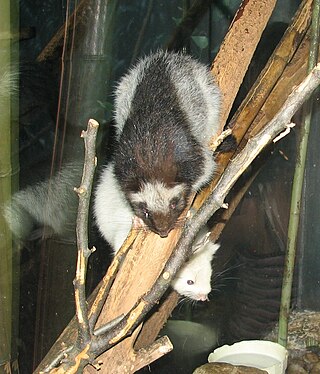
The cloud rats or cloudrunners are a tribe (Phloeomyini) of arboreal and nocturnal herbivorous rodents endemic to the cloud forests of the Philippines. They belong to the family Muridae and include five genera: Batomys, Carpomys, Crateromys, Musseromys, and Phloeomys. They range in size from as large as 50 cm (20 in) to as small as 74 mm (2.9 in). Cloud rats are threatened by habitat loss and illegal hunting. Several species are endangered or critically endangered.

The Camiguin forest mouse is a forest mouse endemic to the island of Camiguin in the southern Philippines. It has large ears and eyes, a long tail and rusty-brown fur, and it feeds mostly on insects and seeds. This description is based on mice captured during a biological survey conducted in 1994 and 1995 high on the steep slopes of one of the island's volcanoes.
The legislative districts of Dinagat Islands are the representations of the province of Dinagat Islands in the Congress of the Philippines. The province is currently represented in the lower house of the Congress through its lone congressional district.
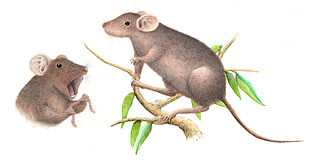
The large Mindoro forest mouse is a species of rodent in the family Muridae, from the genus Apomys. It is found only in the Philippines. Its natural habitat is subtropical or tropical moist montane forests. It is a large mouse with large feet, a long tail and an elongated snout which is morphologically unique within its genus. It is covered in soft fur which is mostly dark brown in colour. Its closest relative is thought to be the Luzon montane forest mouse, based on genetic and morphological similarities.

The large-toothed hairy-tailed rat is one of five species of rodent in the genus Batomys. It is in the diverse family Muridae. This species is found only in Philippines. Its natural habitat is subtropical or tropical dry forests.

The Luzon forest rat or Luzon hairy-tailed rat is one of five species of rodent in the genus Batomys. It is in the diverse family Muridae. This species is found only in the Philippines. This species was the first of the five to be identified and stayed the sole indicator for the genus for roughly 75 years, until 1988. Majority of this species lives on Mount Data which is one of several mountains in the Cordillera Mountains region of Northern Luzon.

The Mindanao hairy-tailed rat is one of five species of rodent in the genus Batomys. It is in the diverse family Muridae. This species is found only in the Philippines.

The Dinagat bushy-tailed cloud rat, Dinagat crateromys or Dinagat cloud rat is a species of cloud rat in the family Muridae. It is one of the eight cloud rats found only in the Philippines, and is specifically endemic to Dinagat Island. It is known locally as hawili. A single specimen was discovered in 1975 by Dioscoro S. Rabor and his team during a scientific survey in Dinagat. The natural habitat is tropical lowland forests, which is facing environmental threats. Habitat loss is caused by progressive deforestation from heavy logging and chromite mining in the area. Almost 40 years after the original discovery, five live specimens were discovered by Milada Řeháková, Václav Řehák and William L.R. Oliver, in 2012.
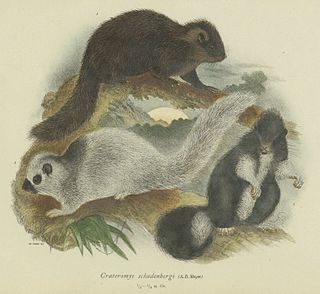
Crateromys is a genus of rodent, native to the Philippines, in the family Muridae. It contains four species extant species, and one extinct species.
The russet free-tailed bat is a species of bat in the family Molossidae. It is found in Cameroon, Democratic Republic of the Congo, Ghana, and Kenya. Its natural habitat is subtropical or tropical moist lowland forests.

Chaerephon is a genus of Old World free-tailed bats in the family Molossidae. Molecular sequence data indicates that Chaerephon, Mops and Tadarida are not monophyletic taxa. The closest relatives of Chaerephon jobimena of Madagascar are Tadarida aegyptiaca of Africa and southwest Asia, and Tadarida brasiliensis of the Americas, which form a clade believed to be about 9.8 million years old. However, the grouping of Chaerephon minus C. jobimena plus Mops was found to be monophyletic.
Big-headed rice rat may refer to either of two oryzomyine rodents:
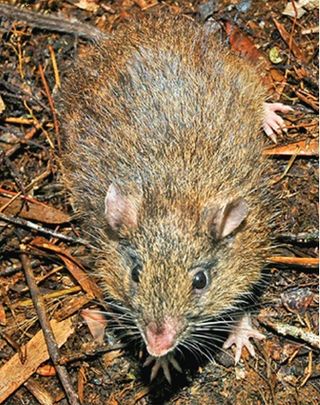
The Hamiguitan hairy-tailed rat is one of five species of rodent in the genus Batomys. It is in the diverse family Muridae. This species is found only in the Philippines. is a yellow-brown animal with a long furry tail, weighs about 175 grams, and is related to several other species known in Central Mindanao, Dinagat Island and Luzon. It lives only in an area that's at least 950 meters high, and in dwarf mossy forests less than 10 square kilometers.
Batomys uragon is a species of cloud rat endemic to the Philippines. It was first discovered in 1988, and the full description was published in 2015, in the Proceedings of the Biological Society of Washington. It is so far found only on Luzon, the largest island in the Philippines. The first specimen was collected from Mount Isarog at the southern side of the island. Other 14 specimens were later collected. It is the fourth species of mammal living only on that mountain. The new species was described by Danilo S. Balete, Eric A. Rickart, Lawrence R. Heaney, and Sharon A. Jansa. It was classified as new species based on DNA analyses and structural descriptions. It is different from its closest relative, the Luzon hairy-tailed rat, in its cytochrome b sequence, moderate body size, colour patterns, and skull structure.
Lawrence Richard Heaney is an American mammalogist, ecologist and biogeographer. His research focus is the mammals of the Philippines.















